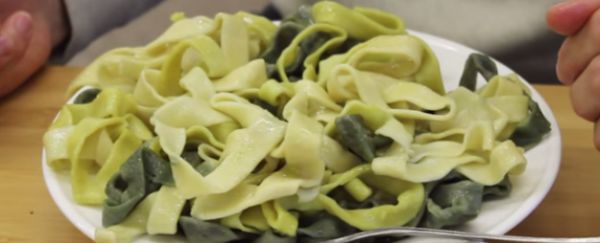A pair of physicists from the University of Warwick have invented a new type of pasta called anelloni to help them figure out one of the last big mysteries in polymer physics.
Polymers are made up of many different molecules strung together to form complex, chain-like structures with wide-ranging properties. Some polymers are synthetic, such as the ones we use to make various types of plastics, while others are entirely natural, found in our bodies in the form of DNA and proteins.
Some polymers - such as those found in bacteria - form strange, complicated ring shapes that can get so tangled up in each other, they appear entirely frozen in place. And no one really knows why, or how. "The thing about ring-shaped polymers … is that they're very poorly understood - in fact, they're one of the last big mysteries in polymer physics," the physicists Davide Michieletto and Matthew S. Turner say in a press release at Phys.org.
In an effort to create a physical analogy of the complex interactions made by ring-shaped polymers, Michieletto and Turner developed large loops of pasta that when served up in a bowl together, form a terrible, tangled mess. Matin Durrani from Physics World filmed what it looks like in the video above.
"This is an analogy of what polymer physicists call a 'mat', which is a very dense solution of polymers, and in this case, ring polymers," says Michieletto in the video. He demonstrates how if he wanted to remove one of the pasta rings from the bowl, he wouldn't be able to without removing another, because the rings have become intertwined, or 'threaded' together. He says that in their supercomputer-modelled investigation into ring-shaped polymers, "threading causes the system to slow down a lot, and it becomes almost like a glass. Which means it takes an exponentially long time to move."
"If this were true in real life - and there is some evidence to suggest that it is - then they believe they would have discovered a new state of matter, which they have called a 'topological glass'," Durrani writes at Physics World.
If topological glass could be mimicked in materials, the movement of individual molecules within the material would change not only due to fluctuations in temperature - such as how regular glassy materials respond to being heated or cooled - but would also change in response to ring length. According to the press release, "Michieletto and Turner believe [this] could inspire novel materials with applications that we cannot yet imagine."
"What would be nice about a topological glass is that its properties would be governed purely by topology, rather than the system-specific chemical details that often control when and how classical glasses form," the pair suggest. "Physicists love that kind of universal behaviour - in fact, obtaining a universal description of glasses has been a central goal in condensed-matter physics for several decades."
We love it when scientists find creative - and delicious! - ways of passing the time between extremely expensive sessions at a supercomputer.
Sources: Phys.org, Physics World
